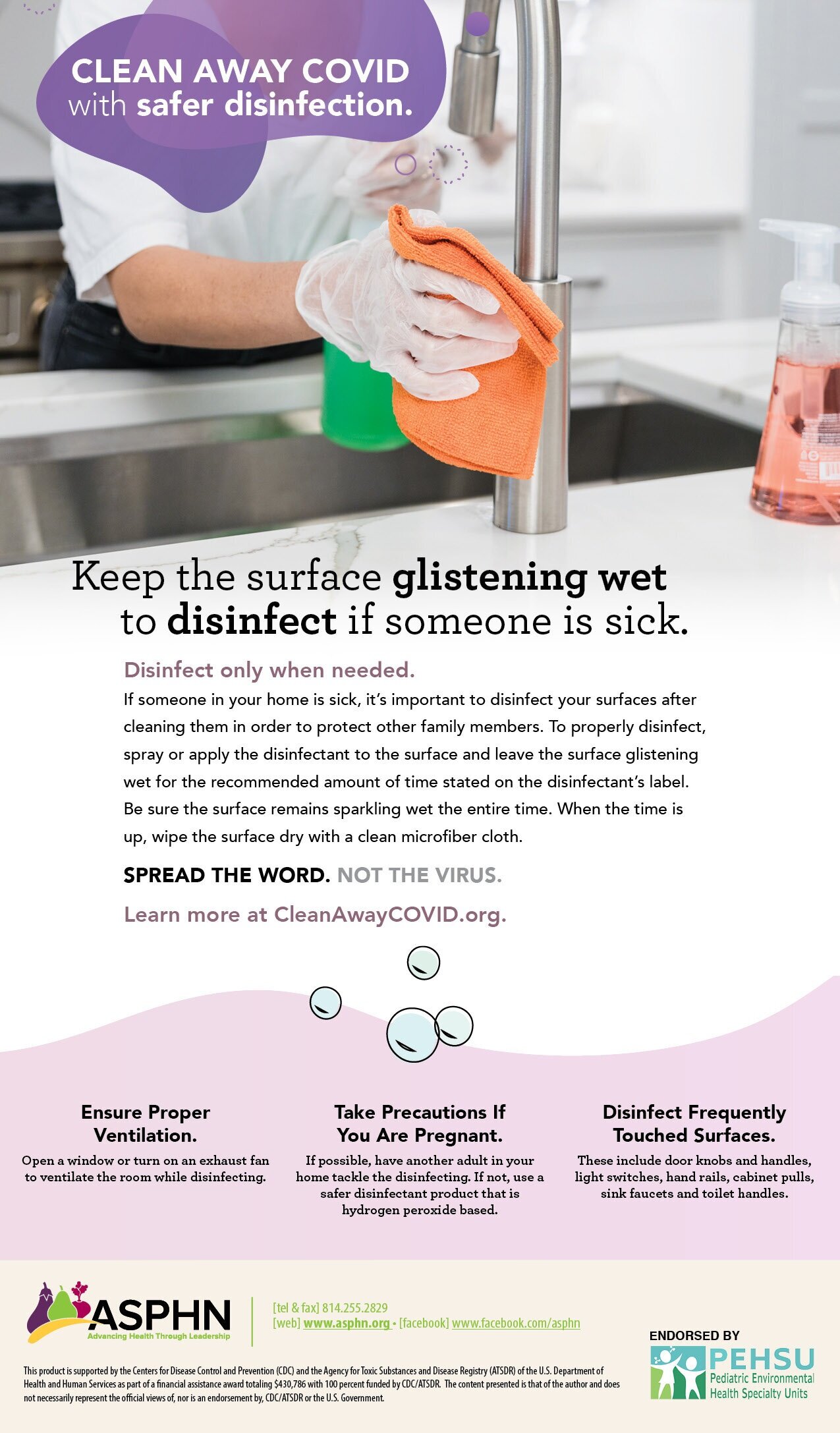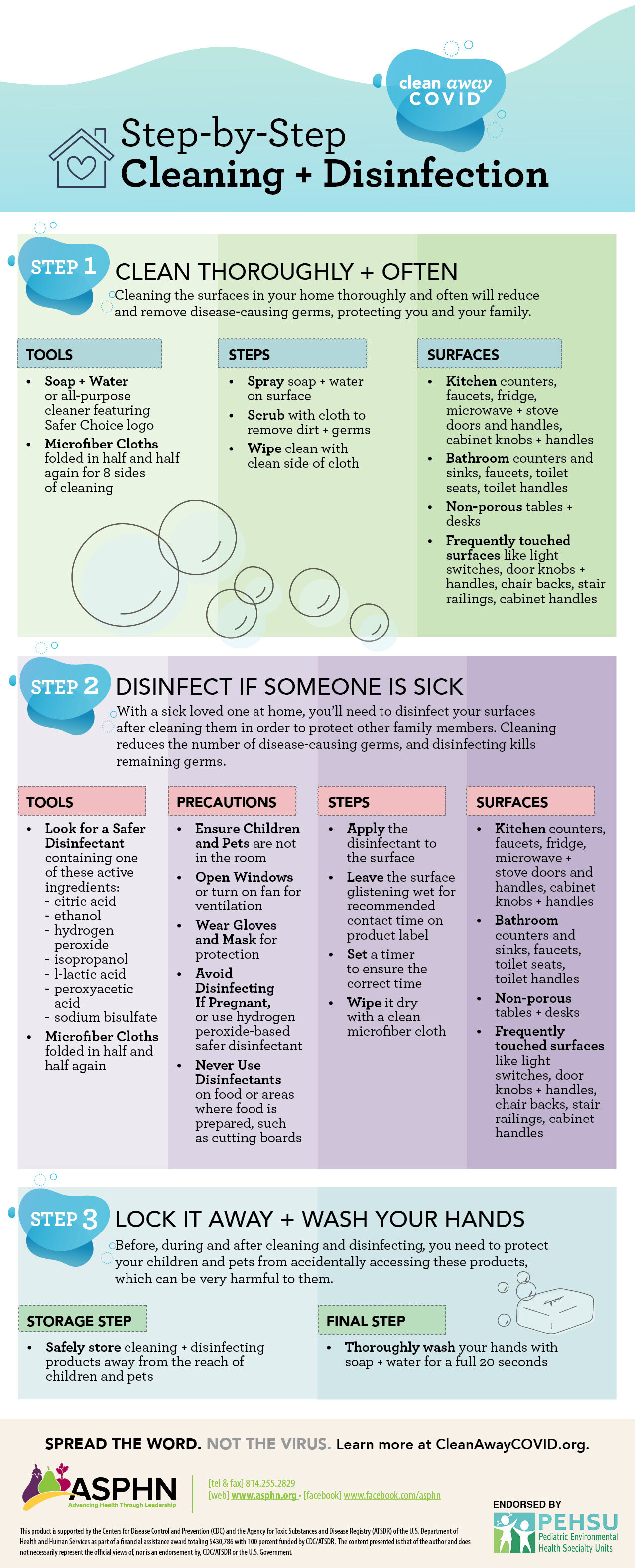Add a disinfecting step to your cleaning routine.
Regularly cleaning with soap and water reduces and removes most germs in your home. However, if someone in your home is sick, it’s important to disinfect your surfaces after cleaning them to protect other family members. Watch this short video to learn more.
Safely disinfect your home after cleaning.
Disinfect step-by-step.
Now that you’ve taken the necessary precautions, here’s how to safely disinfect your home’s surfaces after you have cleaned them:
Gather your disinfectant and clean microfiber cloths
Put on your gloves and a mask
Spray or apply the disinfectant to the surface or stream the disinfectant into your microfiber cloth and wipe the surface with the wet microfiber cloth
Leave the surface glistening wet with the disinfectant for the recommended contact time
Wipe it dry with a clean microfiber cloth
Wash your hands thoroughly with soap and water for 20 seconds after safely storing your products and removing your gloves
Keep the surface glistening wet to properly disinfect.
Disinfectants do not work instantly.
Depending on the formulation, it can take several minutes for a disinfectant to kill germs, and the time it takes for disinfectants to work can vary from product to product.
Always read the label on the disinfectant product to find out how long the disinfectant should remain on the surface for it to be effective. This is called the “contact time.”
When you apply or spray a disinfectant on a surface:
Leave it glistening or sparkling wet for the recommended contact time
Set a timer to make sure it stays on the surface for the correct amount of time
Wipe it dry with a clean microfiber cloth when the timer goes off
Once you’ve finished the disinfecting process, safely store your products, remove your gloves and wash your hands thoroughly with soap and water for 20 seconds
Disinfect the surfaces that are most frequently touched at home.
Think about all the places you touch.
There are many surfaces in your home that get touched over and over again throughout the day. These surfaces include:
Kitchen countertops, islands, sinks, faucets, faucet handles, refrigerator doors, microwave doors, stove door handles and controls, and cabinet handles
Bathroom countertops and sinks, faucets and faucet handles, towel racks, toilet paper holders, toilet seats and toilet handles
Non-porous tables and desks where you family members work or study throughout your home
Frequently-touched surfaces like light switches, door knobs and handles, the backs of chairs, stair railings, and cabinet handles items such as doorknobs and door handles, light switches, stair rails, cabinet handles, sink faucets and toilet handles
After cleaning these surfaces with soap and water, disinfect them by spraying your safer disinfectant directly into your microfiber cloth and then wipe the surface with the wet cloth. Keep the surface glistening wet for the recommended contact time before wiping dry.
Once someone who is sick touches a surface, it must be disinfected again.
Pay special attention to your electronics.
Many electronic devices in your home are also frequently touched. These include remote controls, computer keyboards, touch screens on tablet computers, and smart phones.
If at all possible, place wipeable plastic covers on your electronic devices to protect them from moisture during cleaning and disinfection.
Wipe down these surfaces with a disinfectant wipe that contains at least 70% alcohol for the recommended contact time and then dry the surface thoroughly with a clean microfiber cloth.
ALWAYS check the manufacturer’s instructions for cleaning and disinfecting electronics. Some electronics can be damaged from moisture.
Safely store your cleaning + disinfecting products.
Clean it up. Then lock it away.
Before, during and after cleaning and disinfecting, you need to protect your children and pets from accidentally accessing these products, which can be very harmful to them.
Safely store cleaning and disinfecting products in a high cabinet away from their reach or in a cabinet with a child-proof lock on it.

Spread the word. Not the virus.
Reference these disinfecting resources.
Protect your children and pets by locking away all cleaning, sanitizing and disinfecting products after using them. Watch this short video to learn more.









